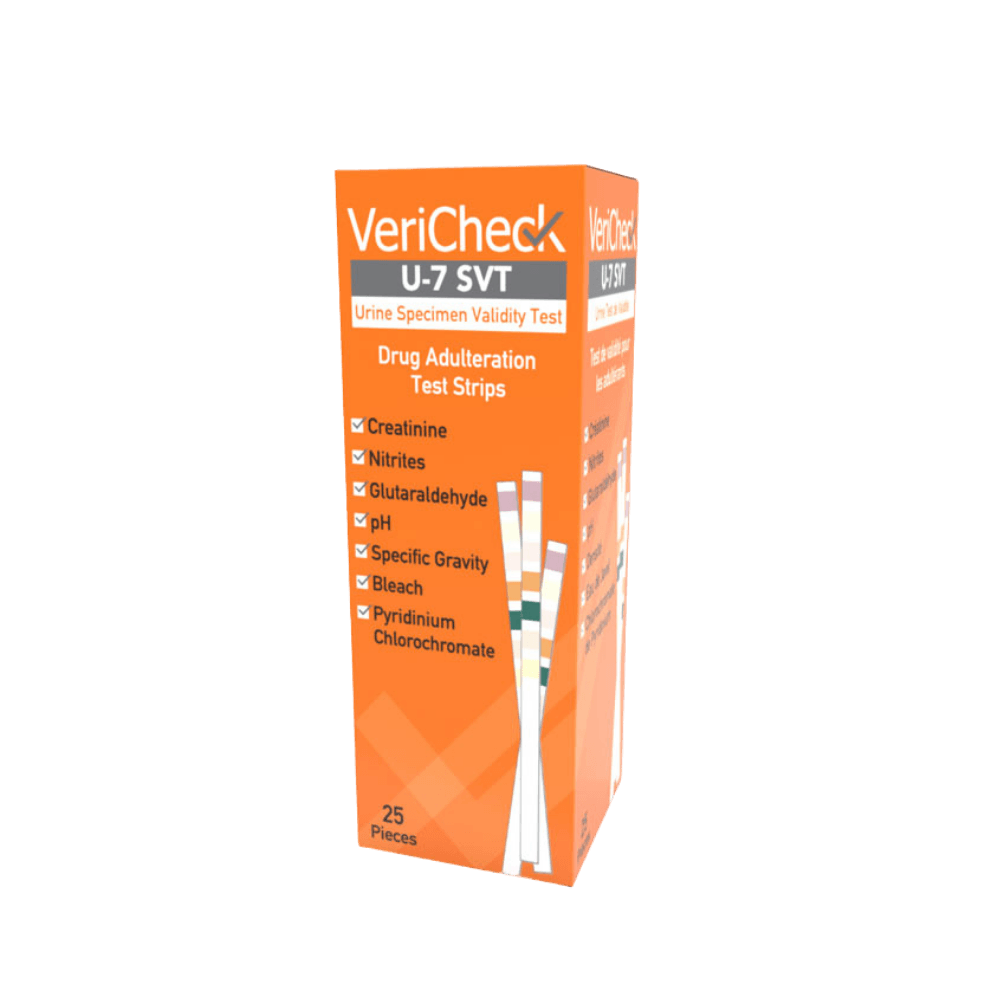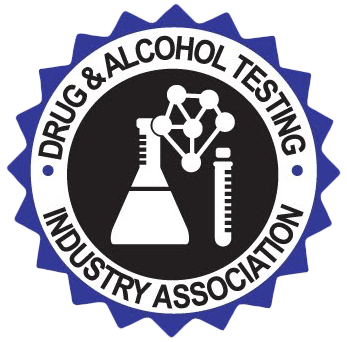Oral Fluid Tests
COVID-19 TESTS
Specimen Validity Test 7-parameter Adulteration Test Strip
VeriCheck® U-7 SVT test strip provides a 7-parameter screen to confirm the validity of urine for the purpose of screening for drugs of abuse. This test tests: Creatinine, Nitrite, pH, Specific Gravity, Glutaraldehyde, Bleach and Pyridinium Chlorochromate.
ATION The validity of screening urine depends on the integrity of the urine sample. Contaminated or adulterated samples may cause erroneous results leading to significant consequences. Hence, it is important to ensure that the samples are consistent with normal urine. The VeriCheck® U-7 SVT will determine: Whether the sample is diluted or substituted with water or other liquids. Whether the sample contains commercially available adulterants including; Stealth, Urine Luck 6.3 and 6.4, Whizzes, Klear, Clear Choice, Instant additive Lucky Lab, LL418, Purafyzit, Clean or detoxifying cleansers. Whether the sample is contaminated with common household items such as; Drano®, bleach, liquid hand soap or vinegar.
WARNING AND PRECAUTIONS
For in vitro use only.
For informational or forensic use only.
Each test strip is single use only.
The desiccant in the strip container is a non-toxic substance silica gel. If the desiccant is inadvertently ingested, drink water immediately and contact your local poison control center for more information.
Used test strips can be disposed of into the general waste/garbage.
Creatinine: Creatinine reacts with a creatinine indicator in an alkaline medium to form a purple brown color complex. The color intensity of the test pad is directly proportional to the concentration of creatinine in the sample.
Nitrites: The test is based on the diazotization reaction of nitrite with an aromatic amine to produce a diazonium salt. It is followed by an .o-coupling reaction of this diazonium salt with an aromatic compound on the reaction pad. The azo dye produced causes a color change from white to pink.
Glutaraldehyde: This analysis is based on the reaction of the aldehyde group on the glutaraldehyde with an indicator to generate a brown color complex.
pH: Double indicator system. The indicator's methyl red and bromothymol blue are used to give distinct color changes from orange to green to blue.
Specific Gravity (SG): Ionic solutes present in the urine cause protons to be released from a polyelectrolyte. When the protons are released it produces a color change of bromothymol blue from blue-green to yellow-green.
Bleach: If Bleach is detected, a color indicator reacts with it to form a blue complex.
Pyridinium Chlorochromate: A color indicator reacts with pyridinium chlorochromate to form red-violet color.
HANDLING PROCEDURE:
Do not open the container until ready to use.
Close the bottle cap immediately after opening. Keep the bottle tightly closed between tests.
Do not remove desiccant from bottle.
Do not touch reagent pad(s) on the strips.
Keep out of reach of children.
SPECIMEN COLLECTION AND HANDLING
Use a clean dry container to collect the urine specimen and test it as soon as possible. If testing cannot be done within an hour after voiding, refrigerate the specimen immediately and let it retum to room temperature before testing. Improperly stored urine specimens (e.g. urine stored for over 4 hours at room temperature) may produce inaccurate results.
Aliquot the small portion of urine sample into another container in order to avoid contamination of the whole urine sample. Do not dip the test strip directly into the primary collection container.
VISUAL TEST PROCEDURE
The procedure must be followed exactly to achieve reliable results.
Dip the strip into the urine no that all tests areas are immersed for no longer than two seconds.
Draw the edge of the strip along the brim of the container or to remove excess urine.
a. Do not let the test areas touch the container.
Tum the strip on its side and tap it once on a piece of absorbent material to remove any remaining urine.
a. Excessive urine on the strip may cause an interaction of
chemicals between adjacent reagent pads which may cause an incorrect result to be interpreted.
After 60 seconds, compare the test results carefully with the color chart on the vial label under good light. While comparing, keep the strip horizontally to prevent possible mixing of chemicals between adjacent reagent pads
On-Site Testing Specialists provides this exam and certification to evaluate the knowledge of an individual in regards to specimen collection, device testing and test interpretation according to the manufacturers recommendations. This certification is NOT an accredited certification for DOT or workplace specimen collection/testing.
VeriCheck U-7 SVT
+
VeriCheck U-7 Adulteration Test Strips
- Ensures the validity of your urine samples
- Detects for adulteration, dilution and substitution
- Simple to use and interpret
- Results in 1 minute
- No instrumentation
- 25 tests per box
Innovative Drug Testing Solutions for over 35 Years
We specialize in all aspects of drug testing & are dedicated to giving you fast, friendly and reliable service.
Innovative Drug Testing Solutions for over 35 Years
We specialize in all aspects of drug testing & are dedicated to giving you fast, friendly and reliable service.
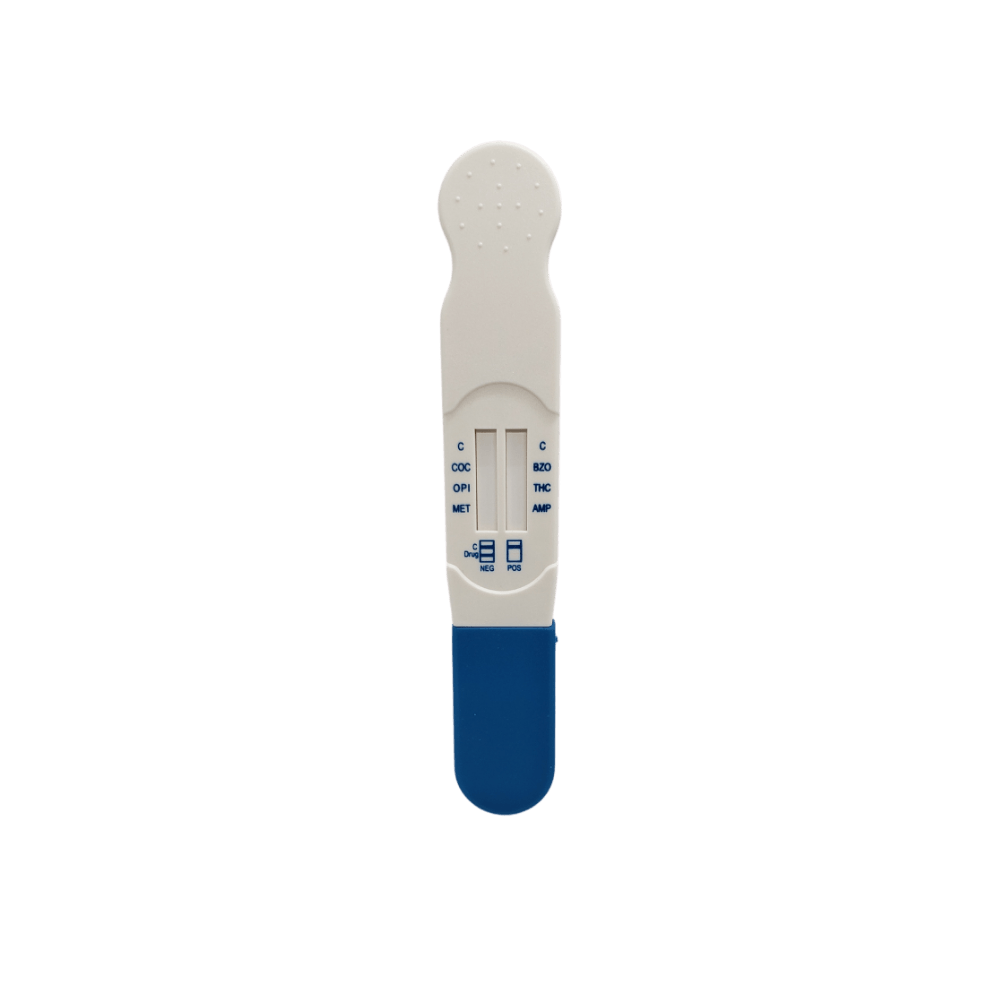
Oral Fluid Tests
- Ensures the validity of your urine samples.
- Detects for adulteration, dilution and substitution.
- Simple to use and interpret.
- Results in 1 minute.
- No instrumentation.
- 25 tests per box.
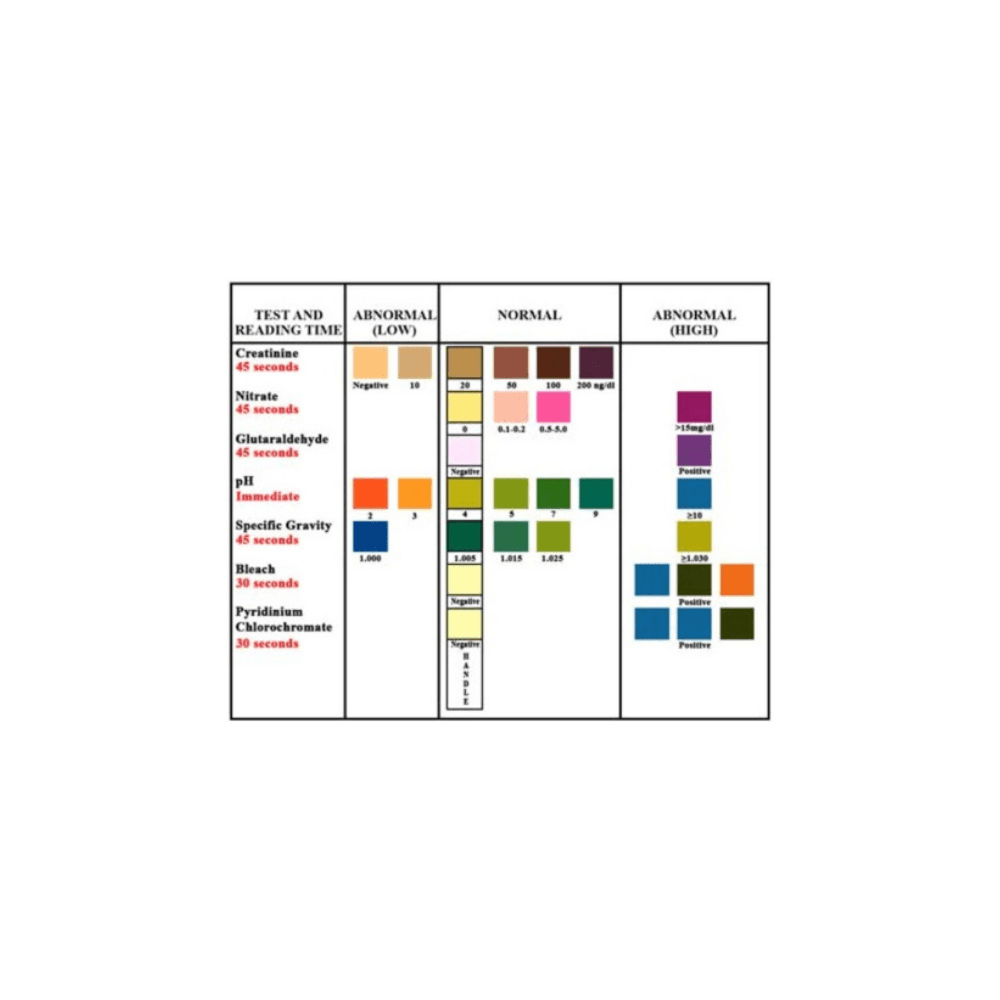
Instructions for Adulteration Test
- The operator can use the UrineCheck 7 as a simple dipstick by dipping the strip into the urine specimen to wet the reagent pads, blotting the pads and laying flat for one minute.
- Alternatively the operator can pipette a drop of urine onto each of the reagent pads.
- The operator interprets test results by comparing the color of each of the reagent pads against the color standards printed on the color chart on the container label. The color chart for each panel has a range of colors that identify the color ranges as normal or abnormal.

Urine Test Cup Certification
On-Site Testing Specialists provides this exam and certification to evaluate the knowledge of an individual in regards to specimen collection, device testing and test interpretation according to the manufacturers recommendations. This certification is NOT an accredited certification for DOT or workplace specimen collection/testing.
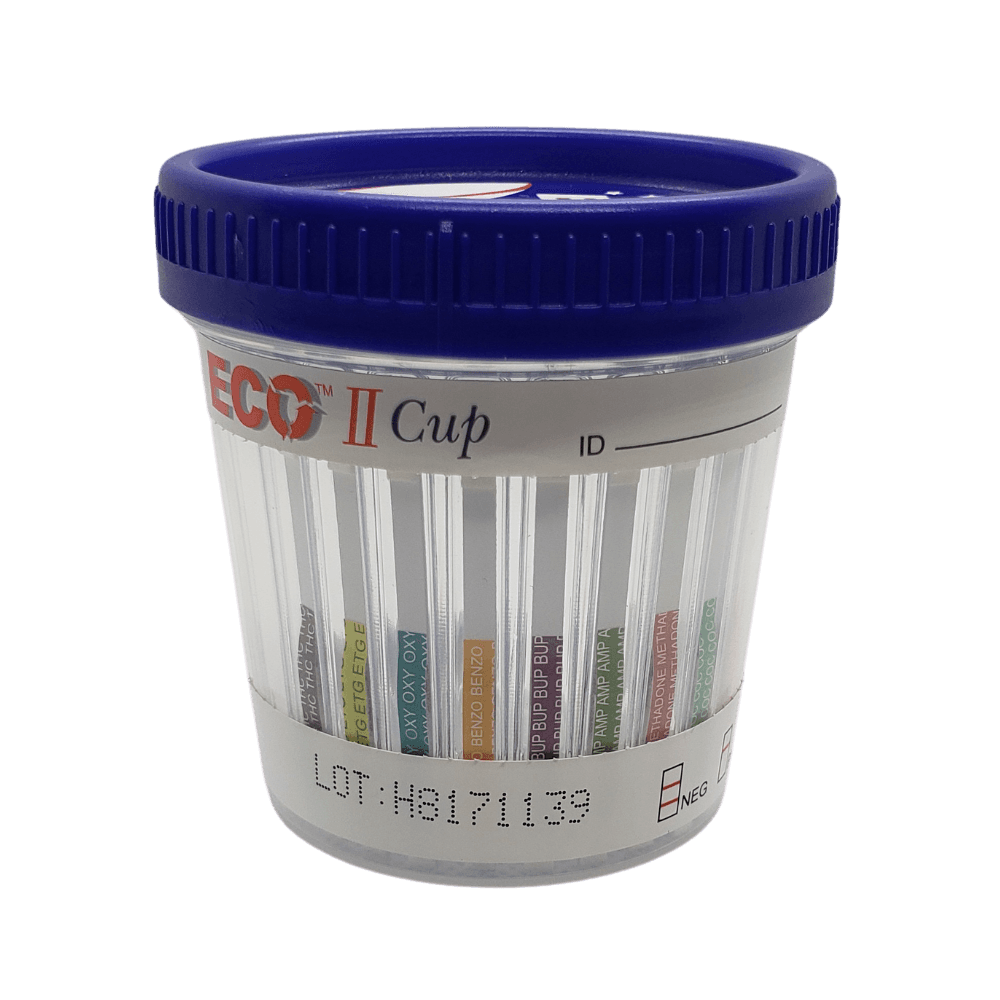
Eco II Cup
- 5 to 14 panel configurations available
- Leak proof design
- Compact, yet still female user-friendly
- Keyless Split Specimen Cup
- FDA 510K Cleared + CLIA Waived
- Adulteration panel available
- Made in the U.S.A.
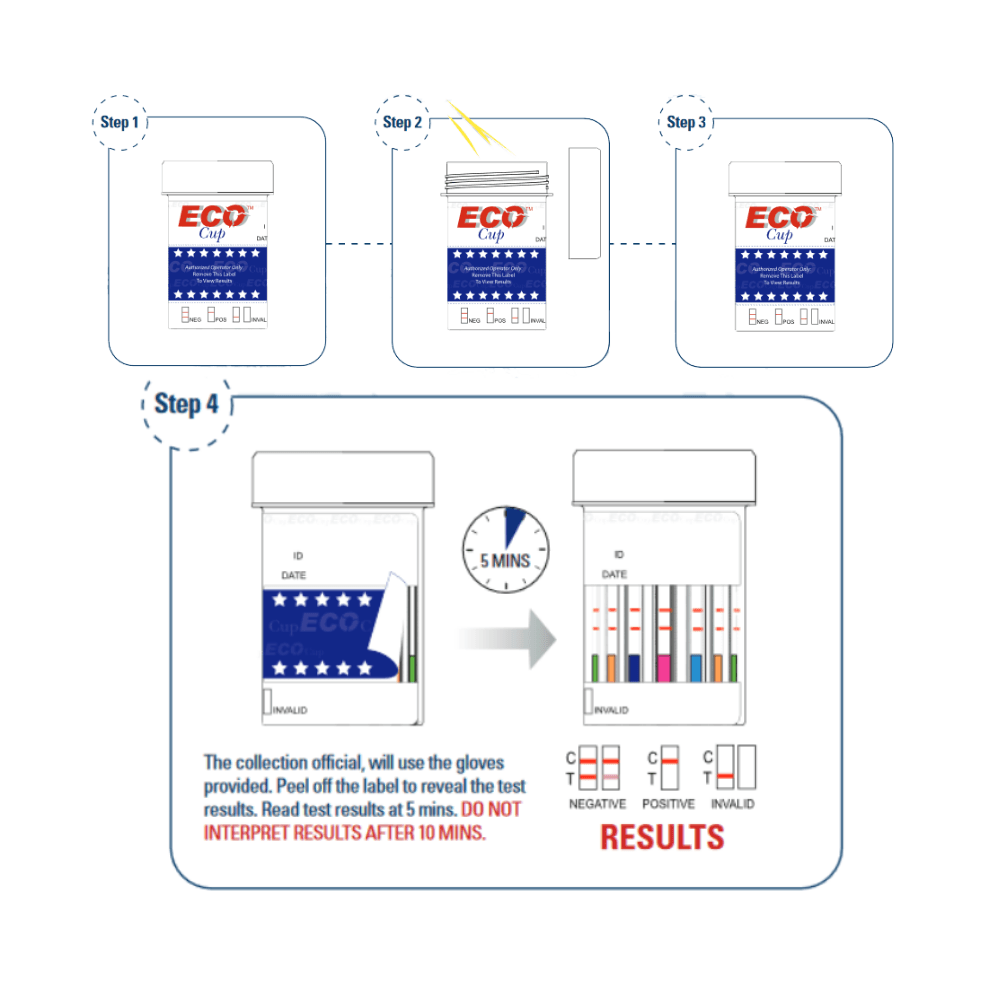
Instructions for ECO CUP I, II and III
- Tear the foil bag open, remove test cup and disposable gloves provided for the donor. Label the device with the donor’s information.
- Wear disposable gloves to collect urine specimen. Open the test cup lid. Urinate directly into the test cup, filling between minimum and maximum as marked on the cup with the urine specimen.
- After the urine specimen has been collected, close the lid securely and return the cup to a collection official.

Urine Test Cup Certification
On-Site Testing Specialists provides this exam and certification to evaluate the knowledge of an individual in regards to specimen collection, device testing and test interpretation according to the manufacturers recommendations. This certification is NOT an accredited certification for DOT or workplace specimen collection/testing.

Saliva Screen 12 Panel Oral Fluid Test
- Easy and convenient to use
- Tests for THC/COC/AMP/MET/BAR/BZO/MOR/PCP/MTD/OXY/MDMA/BUP
- Simple-to-Use 2 piece packaged device
- Observed Collections, very hard to adulterate
- Read results at 5 minutes, not valid after ten minutes
- 25 tests per case

Instructions for Adulteration Test
- The operator can use the UrineCheck 7 as a simple dipstick by dipping the strip into the urine specimen to wet the reagent pads, blotting the pads and laying flat for one minute.
- Alternatively the operator can pipette a drop of urine onto each of the reagent pads.
- The operator interprets test results by comparing the color of each of the reagent pads against the color standards printed on the color chart on the container label. The color chart for each panel has a range of colors that identify the color ranges as normal or abnormal.

Description Title
Write a description for this tab and include information that will interest site visitors. For example if you are using tabs to show different services write about what makes this service unique. If you are using tabs to display restaurant items write about what makes a specific dish particularly worthwhile or delicious.


